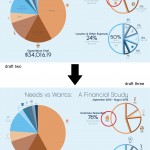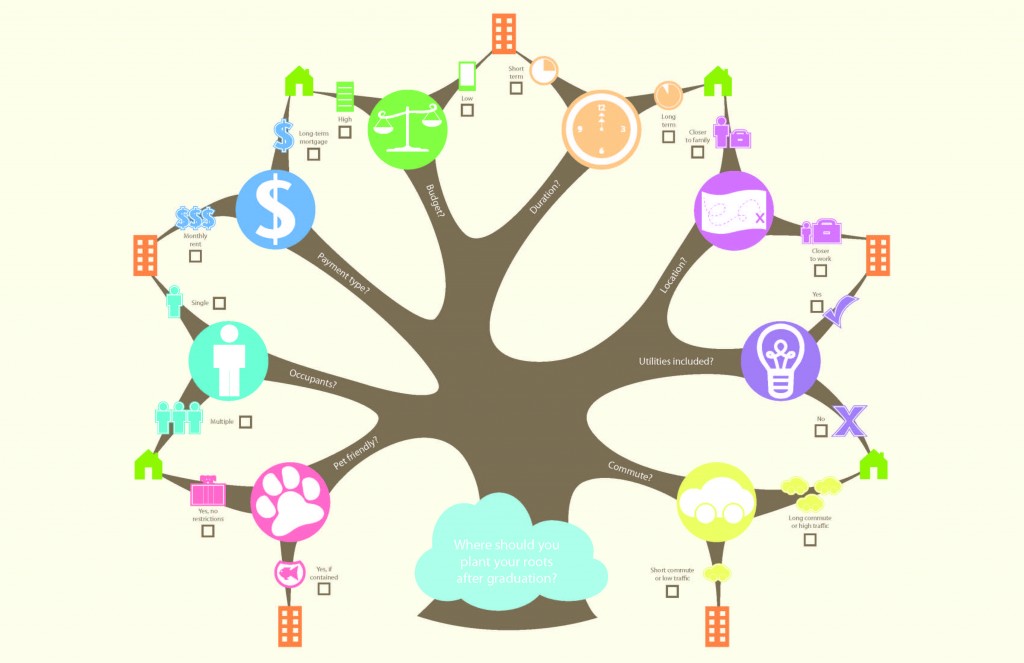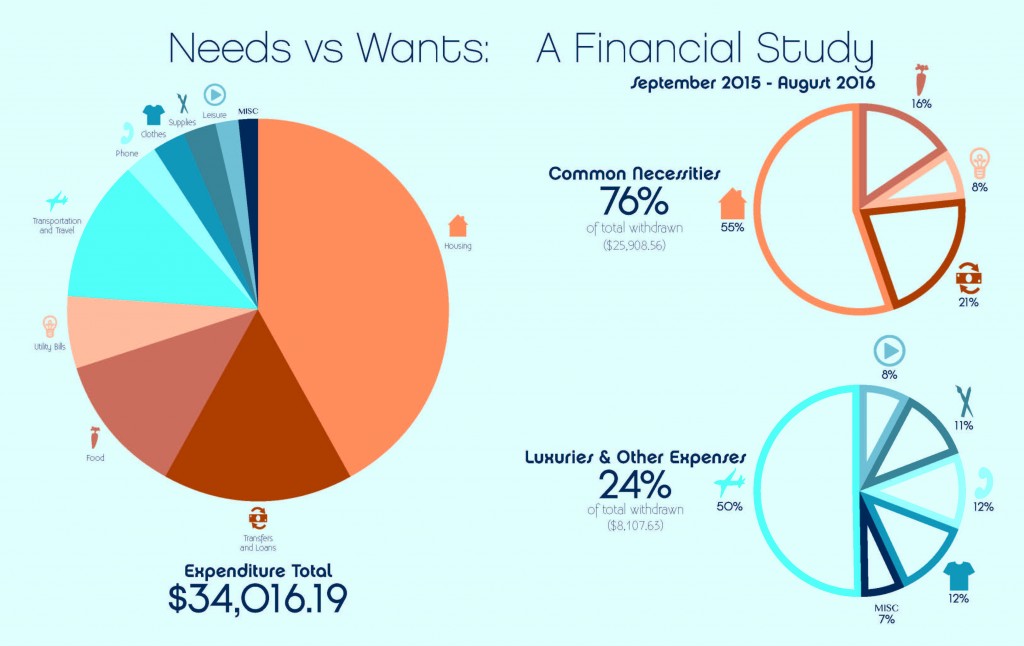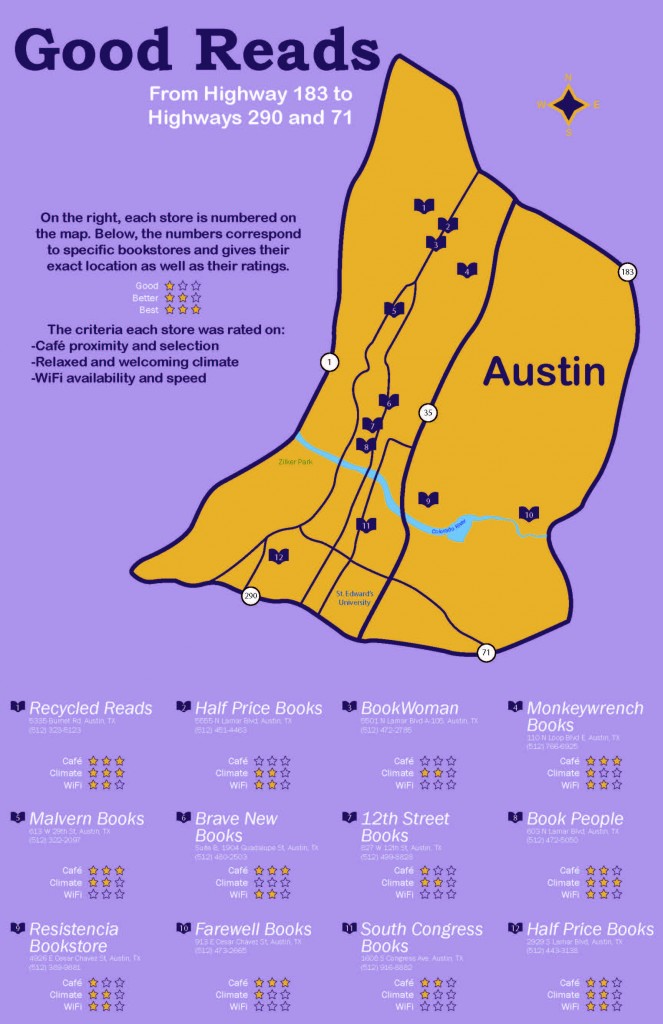Branching Out – Decisions, Decisions
Finally, this last map derives from a decision map that blends preference trees (no pun intended!) with pros-and-cons and satisficing decision techniques. The general question for this map is one that relates to me personally, as I currently live at home and have about a half hour commute to school. I’ve wondered frequently where I’ll end up living once I graduate from college, and so I found it calming to be able to draft out the major categories, or decisions, I would face, and the paths that each choice would take me to.
This map is presented in a fun “checklist” manner, where you assess each sub-decision individually, and at the end compare how many of the apartment avenues were checked compared to the houses.
Needs versus Wants – Visualizing Information
Needs versus Wants is a map that reflects a financial study on Tony Pierce’s bill statement from September 2015 to August 2016. It is meant as a spread in a book, and this particular spread divides several categories of expenses into two broad categories: necessities and luxuries. then, those categories are divided in subcategories so that Tony Pierce can see at a glance what his largest, and smallest, expenses are should he need to start managing his finances!
The most enjoyable part of this particular map was the icons, and the color scheme. I find that blue and orange color schemes are easily recognizable and subtle enough to draw the audience’s attention in, and I was proud with my ability to make distinct icons that are unique from one another and clear representations of their categories.
Good Reads – Personal Geography
This map is a compilation of the local bookstores in south Austin. By local, I restricted the geography to where highways 183, 290, and 71 intersect, since I don’t like going places in Austin without knowing where I’m headed, and I like to stay close to places I know I can navigate easy, such as SoCo near St. Edward’s, and I-35.
For each of the twelve nearby locations, I visited each and considered online reviews to give them ratings on three criteria. The first was whether or not they had a cafe, and what the selections were like. While I don’t drink coffee, I do enjoy other cafe selections and the smell of coffee brewing, and having a cafe is such a classic cliche for bookstores that I love. My second criteria was what the environment, or atmosphere, of the store was like. I wasn’t going to want to repeatedly visit a bookstore that is loud and crowded with staff that don’t know much about what they’re selling. I prefer the quiet, laid-back ones with friendly knowledgeable staff who really know their books. And, lastly, I rated the stores on whether or not they had WiFi and how quick it was, for surfing, streaming, or studying.
GDES 2313 End-Term Assessment
I think that putting in nearly 40, or more than 40, hours a week on practice (more than six hours a day) is excessive, but I think that setting aside less than two hours a day is not enough time to dedicate to improvement. Practicing is essential to improving one’s level of sophistication in their artwork because through practice you learn to troubleshoot technical problems, or you learn shortcuts that can help you later. I’d say that between four and five hours per day of practice time (which can be spent on multiple projects throughout the day, not necessarily a single project in a single time period!) is how much time people should attempt to make to work on practicing and learning new ways to make work, and this is where I’d say I’m at, around four hours a day on various projects, whether they’re individual work or assignments for class.
To me, sophisticated work is careful work. And by this, I mean that sophisticated work has been scrutinized since the first draft by the artist, and has been improved as a result of personal feedback and intuition, but also from critiques from peers. It pays attention to design choices and elements that require an equal balance to be effective. I would say that my maps are sophisticated in the fact that I carefully took into consideration the critiques of my classmates as positive feedback toward improving my designs and making them clean and direct in their readability by the audience. Specifically I paid close attention to color schemes and icons and how to best utilize these elements for emphasis of certain areas of the maps, rather than simply “decoration”.
As stated above, I especially appreciated my peers’ feedback on my icons. I knew that I liked the icons I had done, but I was worried about how they worked in combination with text, and so I really valued the feedback and suggestions that my classmates gave for resolving the issues that I had with balancing my icons and text on my maps. With this feedback I received, I was able to pinpoint specific problems in the maps and make iterations that improved upon and resolved the problems. These critiques/feedback were especially helpful in my second map, as seen below (click to enlarge).

I’d say that the challenges I faced were minor to intermediate; I didn’t really face any extreme difficulties that I couldn’t work around or that caused me to start over on a map. I think the most challenging part of my maps was picking interesting fonts to use that are not default fonts, but rather fonts that are more fitting for the map and information they go with. But once I picked some I liked, I had some peers help me figure out which font(s) would be the most interesting, fitting, and readable for the maps I was doing, so now I have a better idea of the criteria to think about when picking fonts. The easiest and most enjoyable part of my maps was the icons by far. I love to mock up icons and symbols, so those were the most enjoyable for me to do and to fit into my maps.
Outside of class, I do a few other things that do relate to design. Specifically I am interested in mocking up logos for friends, and I also like to design aerial maps of properties, so I liked how the symbol and map assignments we did in class can help me think about design choices for the logos and maps that I’ve already enjoyed doing. I also enjoy creating digital portraits of pets for friends, as far as other extracurricular art projects go. Below are two examples of the most recent portraits I’ve done in two different styles.
-
©2016, Loren Gamez
Jade Portrait
Digital painting, 5″ x 5″
-
©2016, Loren Gamez
Tug-Tug Portrait
Digital painting, 5″ x 5″
As far as my life outside of school affecting my schoolwork, I’d say I’m somewhere between neutral and positive. I always make sure that my schoolwork comes first and that it is finished before I do anything with friends or family, but I also make sure that I do make time for others so that I can relieve any school-related stress. In addition to that, my family and friends are always super supportive of my artwork and even help to offer critiques themselves so that I can receive feedback from non-designer people, as I might if I were presenting a work-in-progress project to a client, so I really appreciate that.
The most ideal version of a class setting, at least for art classes, to me, is one that is fairly individual-based but the overall mood should be relaxed and welcoming, which is how I felt that this class was. By this I mean that students are expected to work in class for the whole class, but they have the opportunity to get answers, feedback, and other suggestions from peers or the professor throughout the class and not just on critique days. I never felt stressed coming to class, because I knew that if I was facing any roadblocks in my work, there were multiple people to get feedback from, or give feedback to. To be a part of class means to be one of these students that can give and receive feedback to peers and to be there to give positive critiques and suggestions where requested. I’d say that I was definitely part of this ideal vision as someone who gave feedback to my peers to help them resolve issues in their projects, and also took any critiques to heart to improve my own work.
Below are my final maps!
Map 1 – Good Reads
Map 2 – Needs versus Wants
Map 3 – Branching Out




